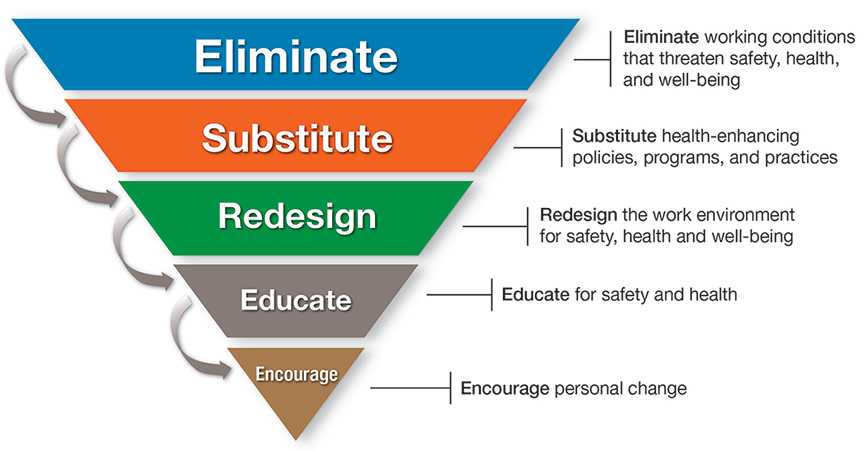TOTAL WORKER HEALTH
Let's Get Started
“I understand the value of advancing worker safety, health, and well-being. Now, how do I get started?”
This site serves as a guide for practitioners for creating or expanding organizational cultures of safety, health, and well-being. Resources on this site will provide information on how to create policies, programs, and practices which protect and promote worker safety, health, and well-being from the organizational and environmental level.
-
Making the Business Case
Information to make the case to invest in the safety, health, and well-being of workers. -
Planning, Assessment, and Evaluation Resources
This page provides planning, assessment, and evaluation resources to help your organization create and sustain a culture of total worker health.
-
Simple Steps You Can Take to Get Started
Examples of simple ways you can begin holistically approaching safety, health, and well-being. -
Promising Practices for Total Worker Health
Examples of employers taking steps to effectively integrate workplace policies, programs, and practices that protect workers' safety and health and advance their overall well-being
Hierarchy of Controls Applied to Total Worker Health®
A Total Worker Health approach prioritizes a hazard-free work environment for all workers. It applies a prevention approach that is consistent with traditional occupational safety and health prevention principles of the Hierarchy of Controls.
Eliminating or reducing recognized hazards in the workplace first, including those related to the organization of work itself, is the most effective means of prevention and thus is foundational to all Total Worker Health (TWH) principles. Although some hazards can be eliminated from the work environment, others (such as shift work) are more difficult to change. These must be managed through various engineering, administrative, or (as the very last resort) individual-level changes. Workplace programs that adopt a TWH approach emphasize elimination or control of workplace hazards and other contributors to poor safety, health, and well-being. This emphasis on addressing environmental determinants of health is a crucial concept for TWH programs.
The Hierarchy of Controls Applied to NIOSH Total Worker Health® provides a conceptual model for prioritizing efforts to advance worker safety, health and well-being. This applied model is based on the traditional Hierarchy of Controls well-known to occupational safety and health professionals. As in the traditional Hierarchy, controls and strategies are presented in descending order of anticipated effectiveness and protectiveness. The Hierarchy of Controls Applied to NIOSH Total Worker Health expands the traditional hierarchy from occupational safety and health to include controls and strategies that more broadly advance worker well-being. The Hierarchy of Controls Applied to NIOSH Total Worker Health is not meant to replace the traditional Hierarchy of Controls, but rather is a companion to this important occupational safety and health model. The Hierarchy of Controls Applied to NIOSH Total Worker Health serves to illustrate how Total Worker Health approaches emphasize organizational-level interventions to protect workers’ safety, health, and well-being. To apply this model:
- Begin by eliminating workplace conditions that cause or contribute to worker illness and injury, or otherwise negatively impact well-being. This includes factors related to supervision throughout the management chain.
- Second, replace unsafe, unhealthy working conditions or practices with safer, health-enhancing policies, programs, and management practices that improve the culture of safety and health in the workplace.
- Next, redesign the work environment, where needed, for safety, health and well-being. Remove impediments to well-being, enhance employer-sponsored benefits, and provide flexible work schedules.
- Then, provide safety and health education and resources to enhance individual knowledge for all workers.
- Lastly, encourage personal change for improvements to health, safety and well-being. Assist workers with individual risks and challenges; provide support for healthier choice-making.
Using the Hierarchy of Controls Applied to NIOSH TWH, a program targeting reductions in musculoskeletal disorders could consist of the following:
- Reorganizing or redesigning the work to minimize repetitive movement and awkward postures
- Providing ergonomic consultations to workers to improve job and workstation design and interfacing, along with ergonomic training and opportunities for workers to participate in design efforts
- Evaluating the age profile and health needs of the workforce to provide education on self-management strategies (including preventive exercise) for arthritis or other musculoskeletal conditions
Similarly, a TWH program reducing work-related stress might consider the following:
- Implementing organizational and management policies that give workers more flexibility and control over their work and schedules, as well as opportunities to identify and eliminate root causes of stress
- Providing training for supervisors on approaches to reducing stressful working conditions
- Providing skill-building interventions for stress reduction for all workers and providing access to Employee Assistance Programs
- Page last reviewed: November 6, 2015
- Page last updated: October 27, 2016
- Content source:
- National Institute for Occupational Safety and Health Office of the Director
TOTAL WORKER HEALTH ® is a registered trademark of the US Department of Health and Human Services



 ShareCompartir
ShareCompartir
